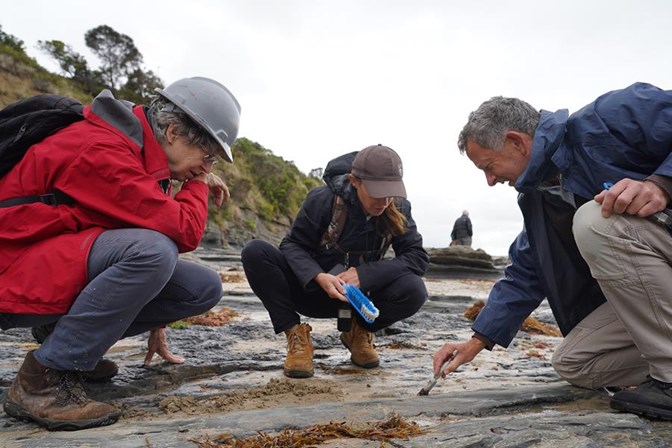New discovery: earliest evidence that birds set foot near south pole 125 million years ago
In a groundbreaking discovery, researchers have identified 27 avian footprints on the Bass Coast of Victoria near Inverloch, dating back to the Early Cretaceous when Australia was still connected to Antarctica.
Published today in PLOS ONE, the findings represent some of the oldest positively identified bird tracks in the Southern Hemisphere, shedding light on early avian evolution.
Professor Anthony Martin, a geologist and palaeontologist from Emory University (Atlanta, Georgia) spearheaded the international team of researchers, including Dr Thomas Rich from Museums Victoria’s Research Institute, alongside other experts from Monash University, the Benemérita Normal School of Coahuila in Mexico, and the Smithsonian Institution.
‘Most of the bird tracks and body fossils dating back to the Early Cretaceous are from the Northern Hemisphere, particularly from Asia,’ explains Professor Martin. ‘Our discovery shows that there were many birds, and a variety of them, near the South Pole about 125 million years ago.’
Local Dinosaur Dreaming volunteer fossil hunter Melissa Lowery, dubbed ‘the doyenne of dinosaur discovery,’ played a pivotal role in the find. Lowery, known for her keen eye, first spotted some tracks in 2020. In a few short years, Lowery has been responsible for the discovery of hundreds of fossils.
Dr Thomas Rich, Senior Curator of Vertebrate Palaeontology at Museums Victoria’s Research Institute and co-founder of Dinosaur Dreaming said, ‘Palaeontologists and citizen scientists have spent decades combing the foreshore around Inverloch for prehistoric life with success – but when Melissa joined our program in 2019, the number of discoveries exploded.’
The 27 bird tracks, found in the Wonthaggi Formation, vary in form and size, with some of the largest dating from the Early Cretaceous. Ranging from seven to fourteen centimetres wide, these tracks resemble those of modern-day shorebirds like small herons and oystercatchers.
Located in the rocky coastal strata where the ancient supercontinent Gondwana began to break up around 100 million years ago, the Wonthaggi Formation offers a glimpse into a polar environment during the Early Cretaceous. The discovery suggests a recurrent presence of various birds, possibly on a migratory route, and provides valuable insights into the ecosystem during polar summers.
While the Wonthaggi Formation is renowned for its polar dinosaur bones, bird fossils are scarce due to their lightweight nature and minimal foot impressions.
‘Since discovering the tracks, we have witnessed the disappearance of seven of them due to coastal erosion. This emphasises the pressing need for documentation and preservation. These fragile finds serve as a unique window into the mysteries of early avian evolution,’ Dr Rich explained.
Museums play a pivotal role in this mission, acting as custodians of our prehistoric heritage. By supporting research and conservation efforts, Museums Victoria Research Institute contributes not only to our understanding of the past, but to ensuring these invaluable traces of history are safeguarded for future generations.








